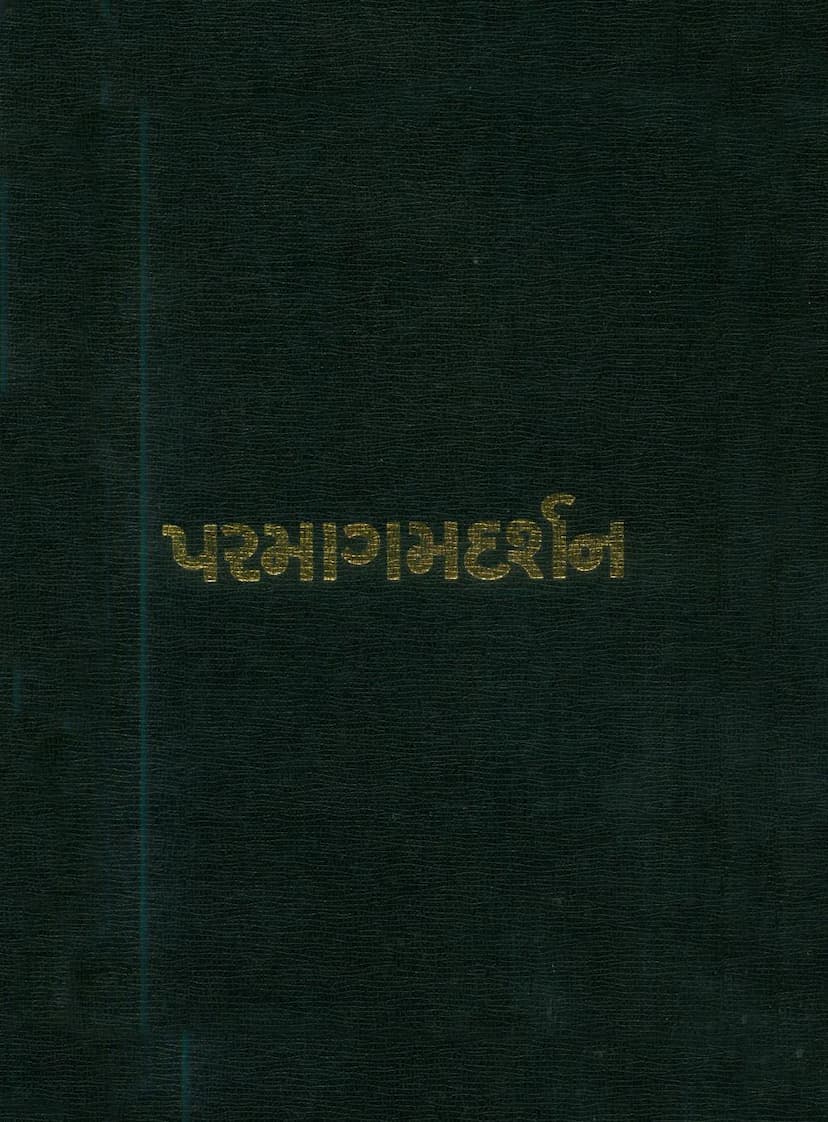Parmagam Darshan
Added to library: September 2, 2025

Summary
This Jain text, titled "Parmagam Darshan" by Ramniklal Savla, is a comprehensive exploration of the core teachings of Jainism, particularly focusing on the profound spiritual philosophies expounded by the revered Acharya Kundakunda. The book serves as an accessible guide for personal study and spiritual upliftment, emphasizing the practical application of these teachings for self-realization.
The text begins with a reverent invocation to the five supreme beings (Panch Parmeshthi): Arihants, Siddhas, Acharyas, Upadhyayas, and all saints. It highlights the author's intention for the text to be used for personal study only, requesting readers to focus on the essence and spiritual benefit rather than minor grammatical or printing errors.
A significant portion of the book is dedicated to introducing and explaining the foundational texts of Digambara Jainism, known as the 'Panch Parmagam'. These are identified as:
- Samaysar (समयसार): Considered the supreme among the Parmagamas, Samaysar elucidates the true nature of the soul through the lens of 'Nishchay Naya' (ultimate truth). It emphasizes the soul's inherent purity, eternal nature, and detachment from all worldly substances. The book highlights the soul's innate spiritual essence as the sole source of true happiness and liberation.
- Pravachan Saar (प्रवचनसार): Following Samaysar, Pravachan Saar delves into the principles of knowledge (Jñana) as the primary path to spiritual realization. It elaborates on the soul's inherent blissful nature, the nature of the knowable (Jñeya), and the path of conduct (Charyānuyoga). The text stresses the importance of cultivating detached conduct and the ultimate goal of achieving liberation from the cycle of birth and death.
- Panchastikaya (पंचास्तिकाया): This scripture provides a foundational understanding of the Jain worldview by describing the six fundamental substances (dravyas) of the universe, which are categorized as five 'astikayas' (substantial entities that have the quality of existence and occupy space) and one non-substantial entity (time). It explains the nature of soul (Jiva), non-soul (Ajiva), movement (Dharma), rest (Adharma), space (Akasha), and time (Kala). The book emphasizes the independent existence of each substance and the concept of cause and effect in the Jain framework. It also covers the nine fundamental truths (Navatatva) and the path to liberation.
- Niyamsar (नियमसार): This text focuses on the essence of 'Niyama' (discipline or regulation), which refers to the path of righteousness – Right Faith (Samyak Darshan), Right Knowledge (Samyak Jñana), and Right Conduct (Samyak Charitra) – as the true path to liberation. It stresses the importance of adhering to these principles with unwavering devotion and diligent practice.
- Ashtapahud (अष्टप्राभृत): This work is a collection of eight profound treatises covering various aspects of Jain philosophy and practice. It serves as a guide for spiritual discipline, offering teachings on right faith, right knowledge, right conduct, spiritual awakening, the nature of the soul, liberation, the significance of Jain symbols (linga), and ethical conduct (sheel).
The text further elaborates on the historical context of Acharya Kundakunda's teachings, placing him immediately after Lord Mahavir Swami and Lord Gautam Swami in the lineage of spiritual masters. His scriptures are considered as authoritative as the words of the Ganadharas (disciples who compiled the scriptures). The book also mentions various titles attributed to Acharya Kundakunda, such as Padmanandi, Elacharya, and Griddhupicchacharya, and recounts his miraculous abilities, including levitation and his visit to Lord Simandhar Swami in the Mahavideh region.
The book meticulously outlines the structure of the Panch Parmagam, detailing the primary subject matter of each of the five main texts:
- Samaysar: Primarily focused on 'Darshan' (Right Faith).
- Pravachan Saar: Primarily focused on 'Jñana' (Right Knowledge).
- Panchastikaya: Explains the six substances and nine tattvas.
- Niyamsar: Focuses on 'Charitra' (Right Conduct) and the path to liberation.
- Ashtapahud: Covers various essential practices and disciplines.
The text provides detailed summaries of the key concepts within each of these Parmagamas, including:
- Nishchay Naya and Vyavahar Naya: The distinction between ultimate reality (nishchay) and conventional truth (vyavahar) is explained, emphasizing that while vyavahar serves as a means to understand nishchay, the ultimate goal is to realize the nishchay truth of the soul.
- The Soul (Jiva): The soul is described as eternal, unchanging, pure consciousness, distinct from all physical and causal substances. It is inherently blissful and possesses infinite knowledge and power.
- Bondage and Liberation: The text explains how karmas (actions and their consequences) bind the soul due to ignorance (mithyatva), passions (kashayas), and sense-pleasures (vishaya). Liberation (moksha) is achieved by eradicating these causes, leading to the soul's inherent pure state of omniscience and bliss.
- The Path to Liberation: The path to liberation is identified as the Three Jewels (Triratna): Right Faith, Right Knowledge, and Right Conduct, which are collectively known as 'Samadarsan-Jñāna-Chāritra'. This path requires detachment from worldly desires, control over the senses, and the cultivation of virtues like non-violence, truthfulness, non-stealing, celibacy, and non-possession.
- The Nature of Reality: The book clarifies the Jain metaphysics of six substances (dravyas) – Jiva, Pudgala, Dharma, Adharma, Akasha, and Kala – emphasizing their independent existence, inherent qualities, and the cyclical nature of cause and effect.
- Ethical Principles: The teachings underscore the paramount importance of Ahimsa (non-violence) in thought, word, and deed, along with other ethical principles like truthfulness, non-stealing, celibacy, and non-possession as essential for spiritual progress.
The book includes numerous quotes and references to the works of Acharya Kundakunda and other esteemed Jain scholars like Shri Amritchandracharya and Shri Jayatsen Acharya, validating the authenticity and depth of the teachings. The narrative highlights the transformative power of these scriptures, which have guided countless souls towards spiritual liberation throughout history. It also touches upon the historical context of Jainism, including the divergence of the Digambara and Shvetambara traditions, and the importance of adhering to the original teachings for true spiritual advancement.
In essence, "Parmagam Darshan" provides a profound yet accessible overview of the fundamental principles of Jain spiritualism, drawing heavily from the wisdom of Acharya Kundakunda, and aims to guide the reader towards self-realization and ultimate liberation.